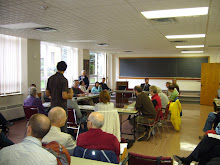skip to main |
skip to sidebar
The Synergy between Coptic Spirituality and Liturgy and the 13th Century Wall Paintings, St Anthony's Old Church, Monastery of St Anthony, Red Sea
by Helene Moussa - St Mark’s Coptic Museum, Scarborough
 The paintings in the Old St. Anthony’s Church are the most complete and best preserved examples of 13th century Coptic art. They are considered “masterpieces.” The paintings were “uncovered” in 1999 as a result of an extensive three years cleaning and conservation program funded by the US Agency for International Development (USAID) and managed by the American Research Centre in Egypt (ARCE) in collaboration with the Supreme Council of Antiquities and the Monastery. In addition to conservation, an important part of the project has been comprehensive documentation including a publication: Monastic Visions – The Wall Paintings in the Monastery of St. Anthony at the Red Sea, edited by Elizabeth Bolman (2002). The paintings were not seen for at least 400 years. The majority of the paintings were part of a single program with inscriptions dating according to the Coptic calendar, AM 949 (anno martirorum)— AD1233. Inscriptions also indicate that the paintings were initially executed by a Coptic team under the supervision of the master painter, also a Copt named “Theodore” who described himself as the zographis —“the writer of life.” While one can study the conservation accomplishments that have rendered these paintings visible to us, or Coptic medieval iconographic development, the paper will “walk through” the church to illustrate how place and space in this church were carefully constructed to celebrate Coptic identity and spirituality in the liturgical life of the monks and faithful.
The paintings in the Old St. Anthony’s Church are the most complete and best preserved examples of 13th century Coptic art. They are considered “masterpieces.” The paintings were “uncovered” in 1999 as a result of an extensive three years cleaning and conservation program funded by the US Agency for International Development (USAID) and managed by the American Research Centre in Egypt (ARCE) in collaboration with the Supreme Council of Antiquities and the Monastery. In addition to conservation, an important part of the project has been comprehensive documentation including a publication: Monastic Visions – The Wall Paintings in the Monastery of St. Anthony at the Red Sea, edited by Elizabeth Bolman (2002). The paintings were not seen for at least 400 years. The majority of the paintings were part of a single program with inscriptions dating according to the Coptic calendar, AM 949 (anno martirorum)— AD1233. Inscriptions also indicate that the paintings were initially executed by a Coptic team under the supervision of the master painter, also a Copt named “Theodore” who described himself as the zographis —“the writer of life.” While one can study the conservation accomplishments that have rendered these paintings visible to us, or Coptic medieval iconographic development, the paper will “walk through” the church to illustrate how place and space in this church were carefully constructed to celebrate Coptic identity and spirituality in the liturgical life of the monks and faithful.
 The paintings in the Old St. Anthony’s Church are the most complete and best preserved examples of 13th century Coptic art. They are considered “masterpieces.” The paintings were “uncovered” in 1999 as a result of an extensive three years cleaning and conservation program funded by the US Agency for International Development (USAID) and managed by the American Research Centre in Egypt (ARCE) in collaboration with the Supreme Council of Antiquities and the Monastery. In addition to conservation, an important part of the project has been comprehensive documentation including a publication: Monastic Visions – The Wall Paintings in the Monastery of St. Anthony at the Red Sea, edited by Elizabeth Bolman (2002). The paintings were not seen for at least 400 years. The majority of the paintings were part of a single program with inscriptions dating according to the Coptic calendar, AM 949 (anno martirorum)— AD1233. Inscriptions also indicate that the paintings were initially executed by a Coptic team under the supervision of the master painter, also a Copt named “Theodore” who described himself as the zographis —“the writer of life.” While one can study the conservation accomplishments that have rendered these paintings visible to us, or Coptic medieval iconographic development, the paper will “walk through” the church to illustrate how place and space in this church were carefully constructed to celebrate Coptic identity and spirituality in the liturgical life of the monks and faithful.
The paintings in the Old St. Anthony’s Church are the most complete and best preserved examples of 13th century Coptic art. They are considered “masterpieces.” The paintings were “uncovered” in 1999 as a result of an extensive three years cleaning and conservation program funded by the US Agency for International Development (USAID) and managed by the American Research Centre in Egypt (ARCE) in collaboration with the Supreme Council of Antiquities and the Monastery. In addition to conservation, an important part of the project has been comprehensive documentation including a publication: Monastic Visions – The Wall Paintings in the Monastery of St. Anthony at the Red Sea, edited by Elizabeth Bolman (2002). The paintings were not seen for at least 400 years. The majority of the paintings were part of a single program with inscriptions dating according to the Coptic calendar, AM 949 (anno martirorum)— AD1233. Inscriptions also indicate that the paintings were initially executed by a Coptic team under the supervision of the master painter, also a Copt named “Theodore” who described himself as the zographis —“the writer of life.” While one can study the conservation accomplishments that have rendered these paintings visible to us, or Coptic medieval iconographic development, the paper will “walk through” the church to illustrate how place and space in this church were carefully constructed to celebrate Coptic identity and spirituality in the liturgical life of the monks and faithful.





